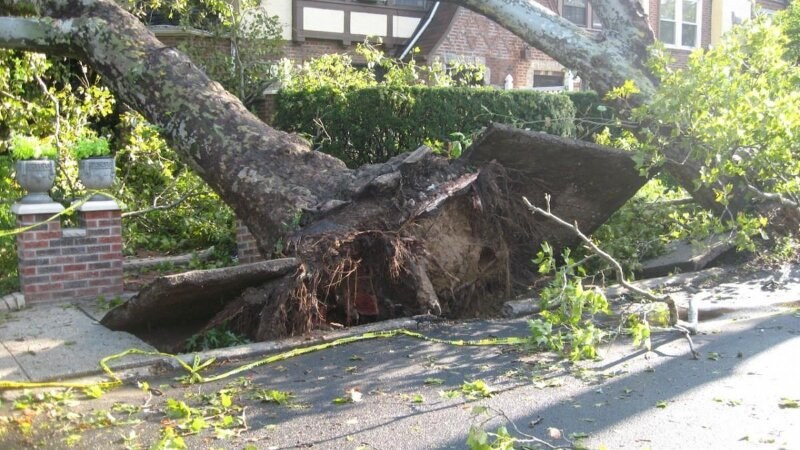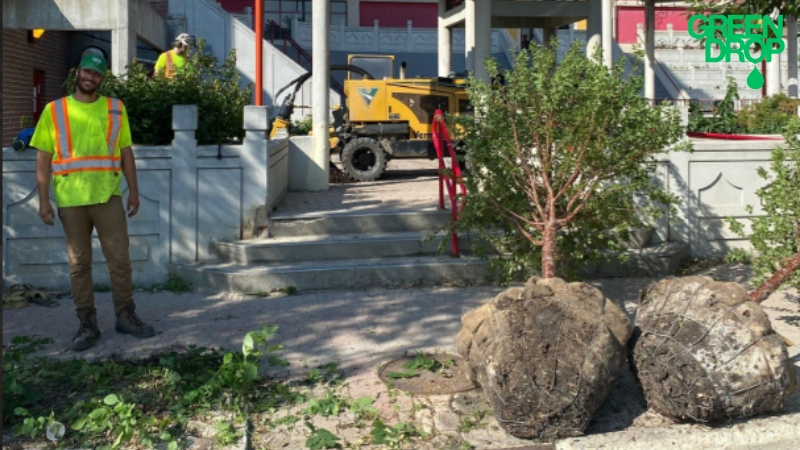Rooting for Recovery: Emergency Care for Uprooted Trees in Winnipeg
Reading time: 6 minutesWhen a storm leaves a tree uprooted in your Winnipeg yard, it tugs at the heartstrings, especially when it’s as much a part of your home as the furniture inside. Imagine that old oak that shaded your family picnics or the maple you watched turn fiery red each fall.
The good news: not every uprooted tree meets its end. There are some options to give them a fighting chance. So, sit back as we discuss how to provide emergency care for uprooted trees.

Why Do Trees Uproot
The mighty don’t always fall because they’re old and frail, but often because of the conditions around them that weaken them.
- Soil Saturation: Winnipeg's soil types vary widely, and during heavy rains, soils like clay can become overly saturated, losing grip on tree roots. This waterlogging creates a slick and unstable foundation.
- Drought: Extended dry periods cause the soil to shrink and harden, creating gaps where roots lose their once-firm hold, reducing stability.
- Strong Winds: High winds are notorious for testing tree stability, especially when other environmental conditions have already weakened the trees' defences.
- Age: Older trees, despite their majestic appearance, often have compromised root systems either through natural ageing or space constraints in urban settings, making them more likely to topple.
- Disease and Decay: Diseases such as root rot or fungal infections can silently destroy root health from within. They diminish a tree’s ability to absorb nutrients and water, which is crucial for maintaining root strength.
- Pest Infestations: Pests like borers and bark beetles target weakened or stressed trees, further impairing their structural integrity from the inside out. Infected trees are more vulnerable to environmental forces.
Your First Response to Uprooted Trees
Before approaching the uprooted tree, ensure it hasn't damaged any power lines or structures, or that it doesn’t pose any other immediate risk. If any utility lines are involved, contact 911 before proceeding.
Next, carefully examine the uprooted tree to determine the extent of the damage. If more than one-third of the root system is still intact and the tree is not excessively large, there might be a chance for revival.
To prevent the roots from drying out, cover them with moist soil or mulch immediately. This temporary measure protects the roots from sun and wind damage, giving you a bit more time to plan your next steps.
Call in professional arborists. ISA-certified arborists will be able to provide a detailed risk assessment and practical recovery or removal solutions.
Saving Uprooted Trees

Can This Tree Be Saved?
There are a few critical factors that dictate if an uprooted tree can be saved. The most crucial of them is the condition of the tree’s root system. If a substantial portion of the roots (more than 50%) is still intact and healthy, the tree has a better chance of survival. Severely damaged or dried-out roots significantly reduce the likelihood of successful replanting.
Smaller, younger trees are generally more resilient and easier to replant due to their lighter weight and more flexible root systems. Larger, older trees, however, have more extensive root systems and heavier canopies, making them harder to stabilize. Older trees are also more likely to suffer from shock.
Remember, the quicker a tree is repositioned and stabilized after being uprooted, the better its chances of survival. Delays may lead to root dehydration and increased stress from environmental exposure, which may drastically reduce recovery prospects.
Step-by-Step Guide to Replanting Uprooted Trees
Replanting an uprooted tree is a challenging endeavour, but you can give them a chance at a second life.
- Step 1: Prepare the New Site. Select a location that matches the tree's needs for sunlight, soil type, and space. Dig a hole twice as wide as the root ball but no deeper, ensuring the tree sits at its original soil line. This prevents burying the trunk too deeply, which can cause rot.
- Step 2: Inspect and Trim the Roots. Before placing the tree in the new hole, carefully inspect the roots. Trim any broken or damaged roots to prevent diseases from entering and encourage the growth of new, healthy roots.
- Step 3: Position the Tree. Gently place the tree in the center of the hole. We have to make sure it's straight and at the correct depth. Backfill the hole with soil, avoiding fertilizers at this stage (they may burn fresh roots). Firm the soil around the base to remove air pockets but avoid excessive compaction. All of this is tricky.
- Step 4: Stabilise the Tree. Use stakes and soft ties to stabilize the tree, especially if it's in an exposed or windy area. Position stakes outside of the root area and tie them loosely enough to allow for some natural movement, which promotes stronger root growth.
- Step 5: Water Thoroughly. After planting, water the tree generously to settle the soil around the roots and provide essential moisture. Continue to water deeply and regularly, depending on weather conditions and soil type, to support the tree during its critical recovery phase.
- Step 6: Mulch and Protect. Apply a layer of organic mulch around the base of the tree, extending out to the drip line. Keep the mulch a few inches away from the trunk to prevent moisture build-up and potential rot. Mulch helps retain soil moisture, suppress weeds, and regulate soil temperature.
- Step 7: Monitor and Care. In the weeks and months following replanting, watch the tree closely for signs of stress, such as leaf wilting or discolouration. If extreme weather is expected, you may need to consider additional support like windbreaks or shade covers.
Caring for Rehabilitated Trees
Successfully replanting an uprooted tree is just the beginning. Long-term care is crucial for its recovery and growth:
- Start with regular health checks to monitor its progress and catch any signs of distress early. Look for new leaf growth and stable, healthy branches as positive indicators.
- Proper pruning plays a vital role in rehabilitation. Initially, prune only the damaged or diseased branches to avoid further stressing the tree. As the tree establishes, routine pruning can help shape it and encourage healthier, more robust growth.
- Make sure the soil around the tree maintains adequate nutrients and moisture levels without becoming waterlogged. Regularly applying organic mulch can help maintain soil moisture and temperature while adding nutrients as it decomposes.
- Adjust your watering schedule based on the season and weather conditions, providing deep watering less frequently to encourage deep root growth.
When to Call in the Professionals
When confronted by an uprooted tree, it’s always wise to defer to professionals who can ensure the tree's and its surroundings' safety. It could well be the difference between saving a tree or losing it. Here are some scenarios that merit a call to professionals:
- The bigger the tree, the more complex the replanting or removal process. Large trees have extensive root systems and heavy canopies that require specialized equipment and techniques to handle them safely.
- Trees located close to homes, power lines, or other structures pose additional risks during uprooting incidents. Arborists can assess the best way to manage the tree without damaging your property or the surrounding infrastructure.
- In cases where trees have suffered significant root or structural damage, the assessment and decision-making process can be complex. Arborists can provide a detailed health assessment, offer stabilization solutions, or determine if removal is the safest option.

Uproot Your Worries and Call in the Green Drop’s Arborists
After the storm, when your trees are down, don't face the aftermath alone. Timely and skilled care is crucial for the recovery of your uprooted trees.
Connect with Green Drop for expert emergency tree care services in Winnipeg. Our arborists are ISA-certified and have the experience to assess and rejuvenate your cherished trees. Get an estimate today, and let us help you restore your uprooted trees and the safety of your yard.
In addition to Winnipeg, our arborists and emergency tree care services are available in Calgary, Edmonton, Red Deer, Regina, and Saskatoon as well.

